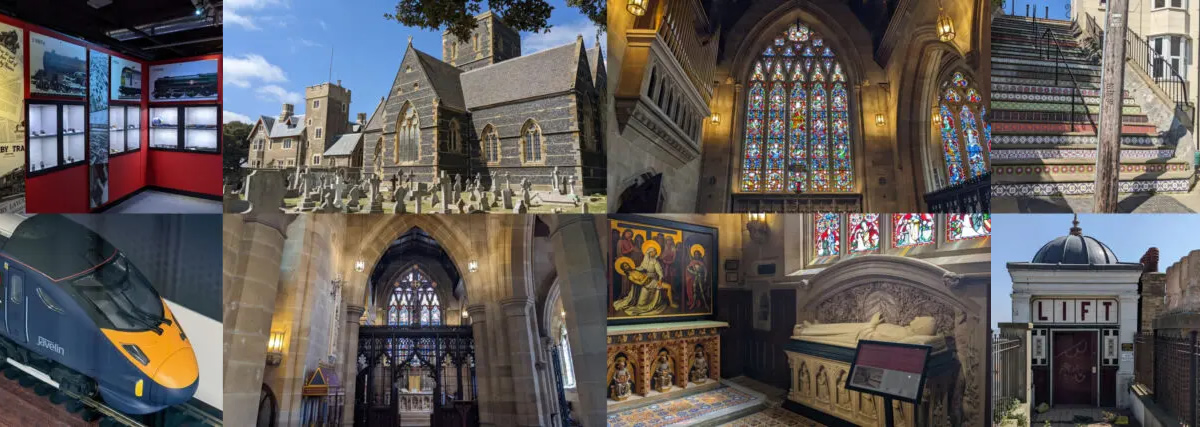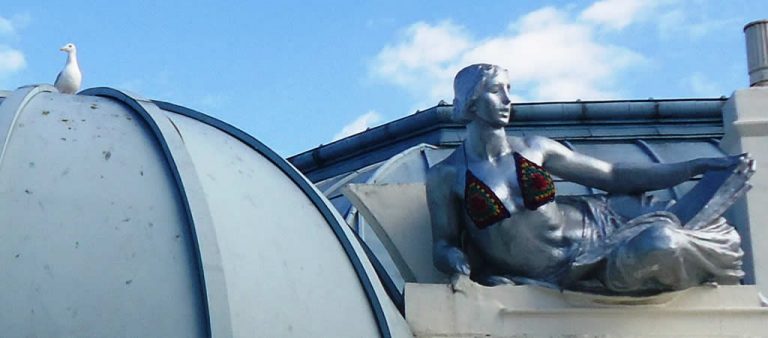Ian Visits Ramsgate
Many thanks to Ian Mansfield AKA Ian Visits for his recent blog about our lovely town and for allowing us to reproduce it here! As an update, both the Micro Museum and This Museum is not Obsolete will both be open every weekend from June and now respectively!
If you want to follow Ian and his adventures, you can find him on facebook twitter or subscribe to his newsletter click on the links!
Ramsgate is a seaside town on the far edge of Kent that boasts a lovely seafront to wander along, an amazing tunnel network to visit, a Pugin chapel, and just outside town, Hornby railways.
All this is just over an hour from central London.
Hornby Visitor Centre

Although not actually in Ramsgate, it’s so close than most regular readers of this website are going to want to visit – a whole museum of Hornby products, from the railways to Airfix and Scalextric
The visitor centre is next to the shop, and once you’ve bought your train ticket entry pass, there’s a number of rooms to wander around, with a mix of model layouts, and mainly lots upon lots of display cases of classic models. All around is the rumbling sound of model trains in their layouts, and even in some of the walls if you notice them there. A few models are button activated, others switch on as you approach.
As with any modern company, tie-ins with popular brands is critical, so expect to see Thomas the Tank Engine and Harry Potter as expected, and Doctor Who which is, well, somewhat less expected. The Scalextric layouts work, and you can gleefully crash cars with abandon. The Airfix displays are a mix of completed models and explanations as to how the models are designed.

All told it’s a mix of sales tool for the newest models, and nostalgia-fest for older sorts spotting their favourite models from years past. Oh, and look very carefully at the model railway by the till, it’s not quite what it seems.
The Hornby Visitor Centre is open daily, and you pay for tickets when you arrive. The easiest way to get there if not driving is by bus, as the Thanet Loop bus runs roughly every 10 minutes and stops right outside (the B&Q stop). The trip from Ramsgate Station takes about 20 minutes.
(There are plans to have a display of full-scale locomotives next door to the Hornby centre, but that’s not expected until 2024)
Back to Ramsgate…
Ramsgate Tunnels

The main reason to visit Ramsgate is the chance to go inside the tunnels that were dug under the town centre, for the railways and later massively extended air raid shelters.
Ramsgate used to have two train stations that were both termini, one on the edge of town as it was then, and one right next to the seafront which also needed a long tunnel to get under the town to get there. In 1923, the two stations were closed when a new railway bypass was built on the edge of town to link the two separate railways into a single line, and a new through station was built on the new line.
The tunnel was turned into a light railway for tourists but closed in 1965, and the tunnels were pretty much abandoned until part of them reopened in 2014 as the Ramsgate Tunnels visitor attraction.
Very rough layout overlaid on Google map

But the railway tunnel is not the main reason people visit – because in 1939, another set of smaller but much longer tunnels were dug, in a circle under the town centre, as air-raid shelters. And it’s the chance to walk down these very narrow, and at times head bangingly low tunnels that have people turning up for a visit.
The railway tunnel portal gives a grand and imposing entrance, and inside there’s a bit of WW2 on display, as well as a marvellous model of the railway that used to run through here. After a bit of a briefing, donning hard hats and grabbing torches, it’s time to head into the much smaller WW2 tunnels. Dug out of the chalk, and apart from a compacted sand floor, the tunnels are left in their raw state. During the war, the tunnels, which could house around 12,000 people were lined with benches, or for the key workers of the time, there were beds available. All around town, there are a number of staircases down to the tunnels, so that no one would be more than 10 minutes from a shelter.
The tunnel tours take you to the first of these entrance stairs, as something caused a bit of a landslide further down the tunnels, so that’s currently blocked. Along the route, the ventilation shafts are shown off, an old bike from the post-war antics, toilets, a section reinforced with concrete, and lots of long winding tunnels to walk through.

As a visitor attraction, it’s done very well, quite atmospheric with only some of the tunnel lit, so you’re using torches for the rest, to make it more fun, and the tour guide gave lots of anecdotes about the people who built the tunnels and then used them during the war to shelter from bombs.
The tours last about 90 minutes and need to be booked in advance from here.
The Micro Museum

On a side road in the town centre is a small museum of old computers. Very much a personal project of the owner, it’s a couple of rooms packed full of computers from the UK’s heyday of independent computing, where every shape and design of computer was seemingly tested to see which would appeal.
Obviously, classics are here, from the Sinclairs to the BBC Micros, Amstrads and beyond. A huge glass case at the end is filled with more conventional looking beige boxes, but wonderfully, they’ve put the packaging boxes out as well. Those boxes that told you of fun games and frustrated copying code from magazines, and so often hidden away in museum warehouses.
I swooned to see the Sinclair C5, sighed at the Game & Watch, and grimaced at the Sinclar ZX Printer with its silver toilet roll paper.
A number of computers are working, mainly for playing games, and mainly modern(ish) games.
There’s a lot to see in this cramped space, and at just £5 (cash only) to visit, worth it for the nostalgia alone.
This Museum Is (Not) Obsolete
Next to the Micro Museum, but closed on my visit.
Ramsgate Museum
Closed on my visit. The website says open Easter-Sept, but a handwritten note on the door says open from June.
St Augustine, Ramsgate

On the edge of Ramsgate is a Roman Catholic church that’s a site of pilgrimage for the relics of St Augustine, but also a site of pilgrimage for worshipers of a secular nature, for it’s the burial site of Augustus Pugin, the patron saint of gothic revival in the UK.
As a designer, Pugin pretty much set the standard for large municipal buildings in England in the late Victorian era, with massive amounts of gothic revival decoration, that still affects how we see these buildings today.
Pugin loved Ramsgate and built two things there, his home, and the church next to it.
The home, nearly demolished in 1997 (!), but saved and restored, was built to Pugin’s personal taste, and you can spend a weekend here if you fancy sleeping in rooms that look like a miniature Houses of Parliament, as it’s owned by the Landmark Trust, an organisation that restores buildings to then rent out.
(I also saw a sign on the door that they have tours on Wednesday afternoons if you contact them, and their website notes that they are having an open weekend in June)
Next door though is Pugin’s personal church, in that he paid for it himself, although Pugin died tragically young and his sons finished it. He, and his family, are also buried inside the church, in their own personal chantry.
Entry to the church is through a modern entrance, with some display boards and a volunteer who pops up to explain that there are display boards to look at almost as soon as you poke your nose through the door. Half is about St Augustine, the monk who became the first Archbishop of Canterbury, and half is about Pugin, then you’re able to walk down a corridor into the church itself.
Entry is a bit odd as you walk into the altar space first, which Pugin would have deplored, but the rest of the church is totally what any Pugin fan would want to see. So much richly decorated tiling, statues and stained glass, and on my visit, the hint of incense from a recent service.
A decade ago the church gained a new purpose, when, on the 200th anniversary of Pugin’s birth, Archbishop Peter Smith created St Augustine’s as the shrine of St Augustine of England. Thus 474 years after the destruction of St Augustine’s shrine in Canterbury on the orders of Henry VIII and Thomas Cromwell, the shrine was restored. The priests of the Oxford Oratory donated a relic believed to be part of a bone from St Augustine. You can see the relics in the corner by the altar.
On the other side of the church is Pugin’s personal chantry, with his effigy in rest along one wall, and an altar that had once been Pugin’s personal from his home.
You can visit to admire the architecture and the history and to pay homage to St Pugin of Gothic.
All the Anglican churches in Ramsgate were closed, but this church is open 1pm-3:30pm daily, except Fridays and Sundays.
Entry is free, with donations appreciated.
All the rest

Look out for the King Edward VIII postbox next to the Victoria Pavillion/Wetherspoons next to the beach. As the abdication monarch, King Edward reigned for less than a year, so hardly any postboxes with his royal cypher were made, and most of those were later amended. Unnoticed by most people though, there’s an original King Edward VIII postbox here in Ramsgate.
Ramsgate station is a marvel to look at, with its high curved ceiling, wonderful lamps and the parquet flooring is going to give people flashbacks to school assembly halls from their youth.
Down the road from the railway station is a large viaduct leaping over a deep cutting in the landscape. The bus stops are called The Viaduct, and you can see why.
Do pay attention to the architecture on the main road, from the balcony restaurant above the closed Argos, to the art deco Card Factory and the richly decorated Victorian pub by the seafront. Try not to be outraged at how someone punched a plastic pipe through the historic sign above the Wooden Box Gallery.
You can walk out along the piers that surround the harbour, although dodge the people swinging fishing lines and motorists who need to drive a hundred yards rather than walk to the end.
There’s a Peace Memorial on a side road that you can look at from the pavement, but the gates were locked, so peace is denied.
A nice thing about the seafront is that there are quite a few free toilets to use. Shabby, but nice to have the facilities offered.
There are a couple of disused lifts that used to get people from the seashore to the higher cliff. One looks very disused, but the other in the town centre looked like it was open at sea level, until I walked into what turned out to be the shop next door’s warehouse. The signs need changing.
Overlooking the sea is The Granville, a former hotel designed by the Pugin family, and its remarkable turret dominates the skyline, but oddly doesn’t appear on any of the tourist maps.
Winterstoke Gardens to the west of the town centre overlooking the beaches is a series of massive rock gardens, with boulders for rocks and on my visit, clearly very climbable by locals having fun.
In the far distance offshore you’ll be able to see the Thanet Wind Farm, which can generate enough electricity for 240,000 homes.
Very well hidden, up on a side alley, Kent Place, which leads off from the shore by the harbour is a set of steps that were decorated by local schoolchildren using tiles inspired by Pugin’s designs.
Getting to Ramsgate
Trains mainly leave from St Pancras International, via Stratford International, or from London Victoria via Bromley South. Some go via Charing Cross/London Bridge but not often.
A tip, there’s a minimal price difference between the two routes for most weekends, and the HS1 out of St Pancras is so much faster and nicer than going via the London Victoria route. Also, as HS1 also calls at Stratford International, if you can avoid a Zone 1 TfL fare into central London, it’s even cheaper to travel on HS1 than to head into central London for the other services.
Remember, if you buy a RailCard, which is £30 a year, then you get a third off train fares, which often quickly adds up to quite a big saving.
Ramsgate station is on the edge of the town, but the Loop bus service runs regularly into the town centre. I would suggest buying a day-pass bus ticket when booking your train ticket, as it’s quite cheap and saves hassle on the day.




